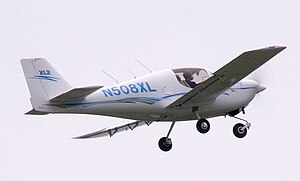Liberty XL2
| XL2 | |
|---|---|
 |
|
| Role | Personal use and training aircraft |
| National origin | United States |
| Manufacturer | Liberty Aerospace |
| Designer | Ivan Shaw |
| Number built | 132 (October 2012) |
| Unit cost |
US$179,000 (Basic VFR version, April 2008)
|
| Developed from | Europa XS |
The Liberty XL2 is a two-seat, low-wing, general aviation aircraft manufactured by Liberty Aerospace of Melbourne, Florida for the personal transportation, touring and flight training roles.
The XL2 is a derivative of the Europa amateur-built kit touring airplane and motor-glider. It was type certified in 2004 under FAR Part 23 for VFR and IFR flight.
Compared to the Europa XS, the fuselage is slightly wider and larger to accommodate bigger American pilots, and also taller with a bigger windscreen. The wing is metal instead of composite and the aircraft is equipped with a Teledyne Continental Motors FADEC-controlled engine mounted on a metal space frame instead of the Europa's Rotax 912 engine mounted on the fiberglass fuselage. The landing gear is also of a different design.
The Liberty was designed by Ivan Shaw, who also created the Europa. The aircraft has a composite fuselage and aluminum wings. The engine is a fuel injected FADEC (Full Authority Digital Engine Control) equipped Continental IOF-240–B driving an MT composite propeller.
The landing gear is of tricycle configuration and all three sprung gear legs are made from 4130 chrome-molybdenum steel alloy. The nose wheel is free-castering. On early versions the nose wheel steering was by differential braking via two finger-controlled brake handles mounted on the centre console. On later versions more conventional toe brakes were installed.
The wing features large fowler flaps pivoting on three scissor hinges per wing, with a maximum 30-degree deflection. The flaps are electrically powered and are controlled by a switch to the right of the radio stack. The flap indicator is a three-light system which shows when the flaps are at zero, twenty and thirty degrees. The flaps can be selected in between those settings but require visual confirmation of flap position. The wing is rectangular with a 7:1 aspect ratio, no taper and no washout. Small stall strips are installed a few feet out from the root to aid stall performance. The airfoil is a unique design, which the XL2 shares with its predecessor the Europa. This is a Don Dykins airfoil, designated as a "Dykins 12%", because the wing's maximum thickness is 12% of the chord. The airfoil is a semi-symmetrical, laminar-flow design. The stall warning system is a voice annunciator that says "stall, stall".
...
Wikipedia
